| Listing 1 - 10 of 84 | << page >> |
Sort by
|
Book
ISBN: 0571094589 Year: 1971 Publisher: London Faber and Faber
Abstract | Keywords | Export | Availability | Bookmark
 Loading...
Loading...Choose an application
- Reference Manager
- EndNote
- RefWorks (Direct export to RefWorks)
Family law. Inheritance law --- architectuur --- architectural criticism --- Architecture --- architectural theory --- architectuurtheorie --- architecture [discipline] --- architectuurkritiek --- -Judgment --- 72 --- 72.072 --- 72.01 --- Architectuurtheorie ; over de beoordeling van architectuur --- architectuurwedstrijden --- architectuurprijzen --- psychologie --- jury --- Judgement --- Knowledge, Theory of --- Language and languages --- Psychology --- Thought and thinking --- Wisdom --- Architecture, Western (Western countries) --- Building design --- Buildings --- Construction --- Western architecture (Western countries) --- Art --- Building --- Decision making --- Architectuur. Bouwkunst --- Wedstrijden (architectuur) --- Architectuurwedstrijden --- Architectuur (theorie) --- Architectuurtheorie --- Architectuur ; theorie, filosofie, esthetica --- Design and construction --- Judgment. --- Decision making. --- 72 Architectuur. Bouwkunst --- 72 Architecture --- Judgment --- Decision-making in architecture
Book
ISBN: 9789027203755 902720375X 9027268908 Year: 2015 Volume: 67 Publisher: Amsterdam, Netherlands ; Philadelphia, [Pennsylvania] : John Benjamins Publishing Company,
Abstract | Keywords | Export | Availability | Bookmark
 Loading...
Loading...Choose an application
- Reference Manager
- EndNote
- RefWorks (Direct export to RefWorks)
This chapter examines the use of the progressive aspect in Black South African English (BSAfE) since the late 19th century in corpora of fiction and newspapers. Previous research points to on-going change in native varieties and the extension to stative contexts in non-native varieties of English. The findings are: There has been a consistent increase in the frequency of the construction. Stative and achievement verbs are used in the progressive aspect proportionally more often in BSAfE than in native varieties. The progressive with stative verbs encodes states of longer duration alongside the
Sociolinguistics --- English language --- Dialectology --- Changement linguistique --- Anglais (langue) --- Variation linguistique --- Variation linguistique. --- Linguistic change --- Intercultural communication --- Globalization --- Variation --- English language - Globalization --- English language - Variation - English-speaking countries --- English language - Variation - Foreign countries --- Linguistic change - Globalization --- Intercultural communication. --- Cross-cultural communication --- Communication --- Culture --- Cross-cultural orientation --- Cultural competence --- Multilingual communication --- Technical assistance --- Historical linguistics --- Language and languages --- Germanic languages --- Globalization. --- Anthropological aspects
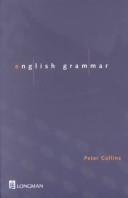
ISBN: 0582809770 9780582809772 Year: 1998 Publisher: Melbourne b Longman:
Abstract | Keywords | Export | Availability | Bookmark
 Loading...
Loading...Choose an application
- Reference Manager
- EndNote
- RefWorks (Direct export to RefWorks)
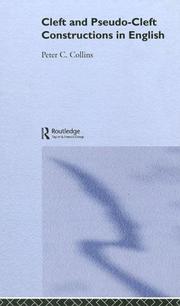
ISBN: 0415063280 9780415063289 Year: 1991 Publisher: London: Routledge,
Abstract | Keywords | Export | Availability | Bookmark
 Loading...
Loading...Choose an application
- Reference Manager
- EndNote
- RefWorks (Direct export to RefWorks)
English language --- Grammar --- Topic and comment --- Discourse analysis --- Sentences --- 802.0-56 --- -English language --- -Germanic languages --- Engels: syntaxis; semantiek --- Discourse analysis. --- Sentences. --- Topic and comment. --- 802.0-56 Engels: syntaxis; semantiek --- -Engels: syntaxis; semantiek --- -802.0-56 Engels: syntaxis; semantiek --- Subject and predicate --- Theme and rheme --- Syntax --- Germanic languages --- English language - Topic and comment --- English language - Discourse analysis --- English language - Sentences
Book
ISBN: 9789042025325 9042025328 9786612594564 9042029099 1441606564 1282594567 9781441606563 9789042029095 9781282594562 Year: 2009 Volume: 67 Publisher: Amsterdam New York, NY Rodopi
Abstract | Keywords | Export | Availability | Bookmark
 Loading...
Loading...Choose an application
- Reference Manager
- EndNote
- RefWorks (Direct export to RefWorks)
Modals and Quasi-modals in English reports the findings of a corpus-based study of the modals and a set of semantically-related ‘quasi-modals’ in English. The study is the largest and most comprehensive to date in this area, and is informed by recent developments in the study of modality, including grammaticalization and recent diachronic change. The selection of the parallel corpora used, representing British, American and Australian English, was designed to facilitate the exploration of both regional and stylistic variation.
English language --- Corpora (Linguistics) --- Grammar --- Study and teaching --- Modality --- Computational linguistics. --- Engelse taal --- Modale werkwoorden. --- Modaliteit. --- Lexicology. Semantics --- 802.0-56 --- 802.0-56 Engels: syntaxis; semantiek --- Engels: syntaxis; semantiek --- Germanic languages --- Corpus-based analysis (Linguistics) --- Corpus linguistics --- Linguistic analysis (Linguistics) --- Grammaticalization. --- Modality. --- English language - Grammar - Study and teaching --- English language - Modality --- Study and teaching.
Book
ISBN: 0571081584 Year: 1971 Publisher: London Faber and Faber
Abstract | Keywords | Export | Availability | Bookmark
 Loading...
Loading...Choose an application
- Reference Manager
- EndNote
- RefWorks (Direct export to RefWorks)
architectural theory --- Architectuurtheorie ; 20ste eeuw --- Oude bouwstijlen in de 19e eeuw. Post-renaissance in de architectuur --- Architectuur ; theorie, filosofie, esthetica --- 72.035 Oude bouwstijlen in de 19e eeuw. Post-renaissance in de architectuur --- 72.035 --- 72.01 --- History --- history [discipline] --- geschiedenis --- Architecture --- architectuurtheorie --- Fonctionnalisme (architecture) --- Architecture moderne
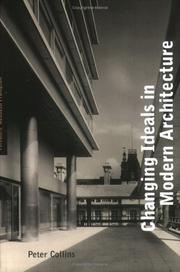
ISBN: 0773517758 0773517049 Year: 1998 Publisher: Montreal, Que. McGill-Queen's University Press
Abstract | Keywords | Export | Availability | Bookmark
 Loading...
Loading...Choose an application
- Reference Manager
- EndNote
- RefWorks (Direct export to RefWorks)
History --- history [discipline] --- geschiedenis --- Architecture --- architectural theory --- architectuurtheorie --- Architecture, Modern --- History. --- Histoire --- Architecture, Modern.
Book
ISBN: 9789027268907 9027268908 9789027203755 902720375X 1336146087 Year: 2015 Publisher: Amsterdam Philadelphia
Abstract | Keywords | Export | Availability | Bookmark
 Loading...
Loading...Choose an application
- Reference Manager
- EndNote
- RefWorks (Direct export to RefWorks)
This chapter examines the use of the progressive aspect in Black South African English (BSAfE) since the late 19th century in corpora of fiction and newspapers. Previous research points to on-going change in native varieties and the extension to stative contexts in non-native varieties of English. The findings are: There has been a consistent increase in the frequency of the construction. Stative and achievement verbs are used in the progressive aspect proportionally more often in BSAfE than in native varieties. The progressive with stative verbs encodes states of longer duration alongside the
Engelse taal en globalisering. --- Engelse taal --- English language --- Linguistic change --- Intercultural communication. --- Varianten. --- Verwante talen. --- Globalization. --- Variation --- Cross-cultural communication --- Communication --- Culture --- Cross-cultural orientation --- Cultural competence --- Multilingual communication --- Technical assistance --- Change, Linguistic --- Language change --- Historical linguistics --- Language and languages --- Anthropological aspects --- Germanic languages
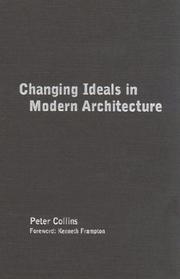
ISBN: 1282854941 9786612854941 0773567054 9780773567054 0773517049 9780773517042 0773517758 9780773517752 Year: 1998 Publisher: Montreal, Que. McGill-Queen's University Press
Abstract | Keywords | Export | Availability | Bookmark
 Loading...
Loading...Choose an application
- Reference Manager
- EndNote
- RefWorks (Direct export to RefWorks)
Collins explains what Revivalism, Rationalism, Eclecticism, and Functionalism meant to those who practised them, examining the impact that social forces and the other arts and sciences had on architectural styles while recognizing the tectonic continuities that underlie the seeming ruptures between pre-modern, modern, and post-modern approaches to design. His work is infused with a deep sympathy for the classical spirit of the eighteenth century and he argued rigorously and passionately that Enlightenment ideas could be of real value to the architects of his generation, particularly since technology had made it possible to use them effectively. Collins's plea for sensitivity to tradition and the urban fabric while encouraging technological innovation and unprecedented programs makes his thought just as vital today as it was ahead of its time when first published.Collins had long wished to see an affordable, fully illustrated edition of his book and McGill-Queen's University Press and the McGill School of Architecture are proud to at long last fulfil this wish. The new edition includes a biographical sketch of Collins, a brief publication history of the work, and an introductory essay by Kenneth Frampton that discusses the importance of the work at the time it was first published and highlights its relevance for the architectural problems of today. Like the classic works of Hitchcock, Giedion, Pevsner, and Benevolo, Changing Ideals in Modern Architecture is essential reading and forms a striking contrast with other works on modernism, such as Reyner Banham's. It will be pertinent to all those interested in architectural history and theory, modern history, history of ideas, and aesthetics.
Architecture, Modern. --- Architecture --- Modern architecture --- History.
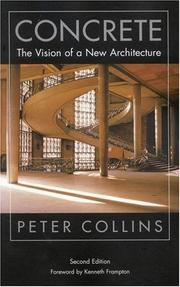
ISBN: 1282861247 9786612861246 0773571191 9780773571198 9781282861244 661286124X 0773525637 9780773525634 0773525645 9780773525641 Year: 2004 Publisher: Montreal, Que. McGill-Queen's University Press
Abstract | Keywords | Export | Availability | Bookmark
 Loading...
Loading...Choose an application
- Reference Manager
- EndNote
- RefWorks (Direct export to RefWorks)
From the Foreword by Kenneth Frampton: "Concrete remains a valuable historical text that in many respects has never been given its due. It is an unmatched pioneering history of the development of reinforced concrete up to 1914. It records and analyses the densely articulated, if provincial, English debate with respect to the aesthetic challenge posed by the increasing popularity of concrete from around 1870 onwards. Finally, until very recently it was the only readily available monograph on Auguste Perret in English. In this regard it is particularly valuable as a thorough and perceptive assessment of Perret's life and career, one that still stands as a point of departure for all current attempts to situate this seminal architect within the wider trajectory of twentieth-century culture."
Concrete construction --- Architecture, Modern --- Building, Concrete --- Concrete building --- Construction, Concrete --- Building --- Architecture --- History. --- History --- Perret, Auguste, --- Concrete construction. --- Construction en béton
| Listing 1 - 10 of 84 | << page >> |
Sort by
|

 Search
Search Feedback
Feedback About UniCat
About UniCat  Help
Help News
News